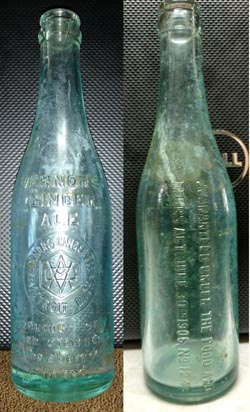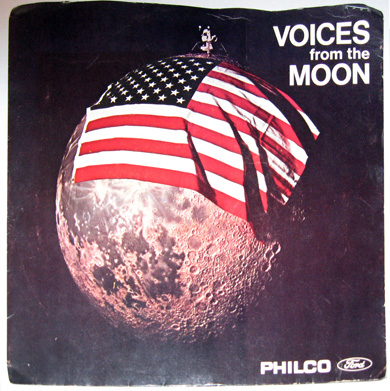 |
|
|||
 |
 |
|||
Copyright © Harry Rinker, LLC 2016 Questions
and Answers
ANSWER: Having grown up in eastern Pennsylvania, I was unfamiliar with Vernors. Besides the national brands—Coca Cola, Hires, Nehi, Pepsi, and 7-Up, I drank Hellertown Beverage and A-Treat soda pop. When I mentioned the brand to my friends in Michigan, their eyes lit up accompanied by phrases such as “my favorite beverage” and “still drink it.” James Vernor, a Detroit pharmacist, created his ginger ale formula in 1866. The product was designed to compete with imported ginger ales. It became commercially available in 1880. Vernors’ distinct taste comes from a caramel additive and being initially aged in oak barrels. Woody,” the Vernors gnome mascot, was used from the early 20th century through 1987, reappearing as the 21st century dawned. As its popularity grew, Vernor sold bottling franchises, insisting that franchises adhere strictly to his recipe. In 1896, Vernor closed his pharmacy and opened a soda fountain on Woodward Avenue south of Jefferson Avenue, close to the Detroit ferry docks. Initially, Vernors was distributed exclusive to soda fountains. By the beginning of the 20th century, it was available for home distribution. Vernors served a Midwest regional market – Ohio, Illinois, and Michigan. The market was expanded to 33 states in 1968. While its popularity is strongest in Michigan’s larger cities, it has a strong following in Florida thanks to the number of transplanted Michiganders. The Vernor family sold the company in 1966. Since then, the brand has seen a succession of owners. It currently is part of the Dr. Pepper Snapple Group of Plano, Texas. [For a detailed history see: en.wikipedia.org/wiki/Vernors] Vernors advertising memorabilia and bottles can be found on multiple internet sale sites. A search of eBay revealed bottles similar to the one you owned priced between $5.00 and $15.00. A search on WorthPoint.com for bottles identical to the one you own provided sell through prices in the $17.50 to $25.00 range. Given Vernors’ long history, there are most likely more than 100 different bottle variations. When researching values, it is critical that exact matches are found. Condition also is critical. Although you did not indicate the exact source of your bottle, chances are it came from a dump, privy, or similar source. If true, it is not in pristine condition. Value for your bottle also depends upon where it is being offered for sale. In Michigan, a reasonable secondary market value is around $15.00. The value drops to $5.00 outside the Midwest. QUESTION: I have a pair of KRON table lamps. The ceramic base is boxed-shaped above a sloped base. There is a green circular medallion with a six-sided star design with a stick star motif in the center surrounded by a dark brown rope design in each of the four sides. The background color is a washed tan. The lamps are 28” tall to the top of the shade mantel. I never heard of Kron lamps. What is their history and value? – NL Council Bluffs, IA, Email Question. ANSWER: I like antiques and collectibles that speak decade. Your lamps date from mid-1950s through the very early 1960s. Having grown up in the era of the matched pair of sofa end tables, often coordinated with a matching coffee table, I can easily imagine these lamps in the homes of my “modern” aunts and uncles. The design is a bit too adventuresome for my parents. Your lamps also reminded me of the famed TV lamps of that era. These lamps sat atop the TV so that you did not watch TV in the dark, a practice that was said to ruin eyes and possibly cause blindness. Texans, Inc., located in Bangs, Texas, made your lamps. Thanks to www.texansinc.com, a website created by David Cole and Mark Stevens, information is ready available about the company and its products, which also included TV lamps along with its table lamps. Richard Gunter and Howard Kron were the co-designers behind Texans, Inc. Lamps produced by Texans, Inc., contain markings indicating the designer – “Gunter,” “RAG,” and “Kron.” Prior to working for Texans, Inc., Kron worked for Haldeman Potteries (CA), Midwest Potteries (Morton, IL and later Tyler, TX). Texans, Inc. was founded in 1952, survived a 1971 fire caused by lightning necessitating the rebuilding of the plant, and ceased operations in the early 1980s. [See: http://www.texansinc.com/ or http://www.tvlamps.net/kron_lamps.html] Stevens’ and Cole’s website contains a URL for the company’s table lamps and TV lamps. I did not find your table lamps among the examples listed. As a result, I recommend you email a picture of your lamps to Stevens or Cole. Researching values is fun. An eBay seller has a Kron lamp that is identical to the one you own with a matching table base listed for $499.99 or best offer. To state that this asking price is overly optimistic is an understatement. What was learned from this listing is that Texans, Inc. apparently made tables that complemented some of their lamps. I found a similar example of a lamp that has red rather than green medallions. The eBay seller has reduced the price from $39.99 to $29.99, still indicating he was open to offers. In Council Bluffs, Iowa, a reasonable secondary market value for the pair of lamps is between $75.00 and $90.00. In a larger urban area, for example, Los Angeles, where Modernist tastes are stronger, the value doubles. QUESTION: I have a Mattel Allan Sherwood doll in its period box. Allan was a friend of Barbie. What is its value? – D, Cheboygan, MI ANSWER: Who is Allan Sherwood? I confess I had no idea until I did research. Mattel introduced its Allan Sherwood doll in 1964, designed to be a buddy of Ken, share his clothing, and as a boyfriend for Midge. Allan lasted only two years. A Ken redesign sealed Allan’s fate. Allan was revived briefly in December 2002 and part of Mattel’s Happy Family line. By then, he was Midge’s husband and father of Ryan, Jenny, and Nikki. Their happiness ended quickly as little was done to develop the line. Allan Sherwood was named after Allan Segal, the husband of Barbara Handler, the daughter of Mattel’s founder. Alan and Barbara divorced in the 1960s, which may explain why Allan Sherwood had a short initial life. [See: http://www.dollreference.com/allan_doll1964-1966.html Allan’s limited appearance in the Barbie line impacts his secondary market value. An eBay listing for a 1964 Allan in his period box and with his striped shirt has a “Buy it Now” price of $39.99. Another eBay seller lists another example with a “Buy It Now” price of $29.95. Barbie may be a “Billion Dollar Baby,” but Allan is not even a fifty bucker. QUESTION: I have a copy of a 33 1/3 rpm record entitled “Voices from the Moon.” The record was a Philco promotional item. My father was a Philco technician in Philadelphia for about 30 years. I assume he acquired it. The record is rather flimsy. What is its value? – CLA, Lansdale, PA, Email Question
ANSWER: Philco apparently gave away a great many of these records. The internet is flooded with offerings. There also appears to be a 45 rpm version. As usual, the asking prices vary considerably. There is a group of “Buy It Now” offers on eBay around $9.00 ($5.00 plus $3.99 shipping). The next grouping is in the $20.00 to $25.00 range. The final grouping is around $40.00 I am not certain why anyone would pay $40.00 for something that can be acquired for $9.00. In terms of your copy, any offer above $5.00 makes you a winner.Harry L. Rinker welcomes questions from readers about
collectibles, those mass-produced items from the twentieth and twenty-first centuries.
Selected letters will be answered in this column.
Harry cannot provide personal answers.
Photos and other material submitted cannot be
returned.
Send your questions to: Rinker on Collectibles, 5955 Mill
Point Court SE, Kentwood, MI 49512.
You also can e-mail your questions to
harrylrinker@aol.com.
Only e-mails containing a full name and mailing address
will be considered.
You can listen
and participate in
WHATCHA GOT?, Harry’s
antiques and collectibles radio call-in show, on Sunday mornings between 8:00 AM
and 10:00 AM Eastern Time.
If you
cannot find it on a station in your area,
WHATCHA GOT?
streams live on the Internet at www.gcnlive.com.
SELL, KEEP OR TOSS?: HOW TO DOWNSIZE A HOME,
SETTLE AN ESTATE, AND APPRAISE PERSONAL PROPERTY
(House of Collectibles, an imprint of Random House Information Group, $17.99),
Harry’s latest book, is available at your favorite bookstore and via
www.harryrinker.com.
|
||||
 QUESTION: I have a Vernors green tinted glass soda bottle that I found in the 1980s in an old lumber town in Upper Michigan. The bottle stands 9 1/4-inches tall. The raised lettering on the front reads: “VERNORS / GINGER / ALE / logo (circle with a ‘V’ logo center surrounded with a circle in which is ‘VERNOR’S GINGER ALE DETROIT, MICH’) / GENUINE ONLY / WHEN CROWN CORK/ HAS ABOVE DESIGN IN RED.” The relief horizontal lettering on the back reads “GUARANTEED UNDER THE FOOD / AND DRUG ACT OF JUNE 30TH 1906 No. 1246.” The crown cork cap is missing. What is my bottle worth? – DD, Mackinaw City, MI, Email Question
QUESTION: I have a Vernors green tinted glass soda bottle that I found in the 1980s in an old lumber town in Upper Michigan. The bottle stands 9 1/4-inches tall. The raised lettering on the front reads: “VERNORS / GINGER / ALE / logo (circle with a ‘V’ logo center surrounded with a circle in which is ‘VERNOR’S GINGER ALE DETROIT, MICH’) / GENUINE ONLY / WHEN CROWN CORK/ HAS ABOVE DESIGN IN RED.” The relief horizontal lettering on the back reads “GUARANTEED UNDER THE FOOD / AND DRUG ACT OF JUNE 30TH 1906 No. 1246.” The crown cork cap is missing. What is my bottle worth? – DD, Mackinaw City, MI, Email Question